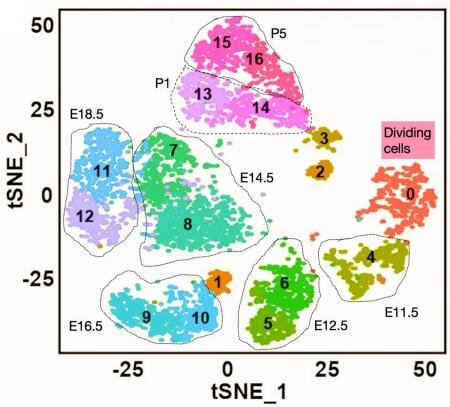Recently published work from Carnegie’s Allan Spradling and Wanbao Niu revealed in unprecedented detail the genetic instructions immature egg cells go through step by step as they mature into functionality. Their findings improve our understanding of how ovaries maintain a female’s fertility.
The general outline of how immature egg cells are assisted by specific ovarian helper cells starting even before a female is born is well understood. But Spradling and Niu mapped the gene activity of thousands of immature egg cells and helper cells to learn how the stage is set for fertility later in life.
Even before birth, germ cells assemble a finite number of cell clusters called follicles in a female’s ovaries. Follicles consist of an immature egg cell and some ‘helper’ cells, which guide the egg through its maturation process. It is from a follicle that a mature egg cell bursts during ovulation.
“Follicles are slowly used up during a female’s reproductive lifespan and menopause ensues when they run out. Understanding what it takes for follicles to form and develop successfully, helps us learn how damaged genes or adverse environmental factors, including a poor diet, can interfere with fertility,” explained Spradling. “By documenting the follicle’s genetic operating manual, problems in egg development that might lead to birth defects—as a result of mutations or due to bad nutrition—can be better understood and reduced.”
Spradling and Niu sequenced 52,500 mouse ovarian cells at seven stages of follicle development to determine the relative expression of thousands of genes and to characterize their roles.
The study also illuminated how mammalian ovaries produce two distinct types of follicles and Spradling and Niu were able to identify many differences in gene activity between them.
The first, called wave 1 follicles, are present in the ovary even before puberty. In mice, they generate the first fertile eggs; their function in humans is poorly understood, but they may produce useful hormones. The second type, called wave 2 follicles, are stored in a resting state but small groups are activated to mature during a female’s hormonal cycle, ending in ovulation. The findings help clarify each type’s roles.
Spradling and Niu’s work and all its underlying data were published by Proceedings of the National Academy of Sciences.
“We hope our work will serve as a genetic resource for all researchers who study reproduction and fertility,” concluded Spradling.
Breast cancer drug, olaparib, depletes store of immature eggs in mouse ovaries
More information:
Wanbao Niu et al, Two distinct pathways of pregranulosa cell differentiation support follicle formation in the mouse ovary, Proceedings of the National Academy of Sciences (2020). DOI: 10.1073/pnas.2005570117
Provided by
Carnegie Institution for Science
Citation:
How an egg cell’s ‘operating manual’ sets the stage for fertility (2020, October 8)
retrieved 8 October 2020
from https://medicalxpress.com/news/2020-10-egg-cell-manual-stage-fertility.html
This document is subject to copyright. Apart from any fair dealing for the purpose of private study or research, no
part may be reproduced without the written permission. The content is provided for information purposes only.



